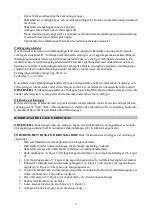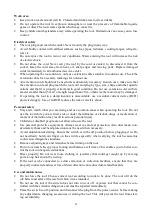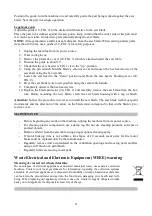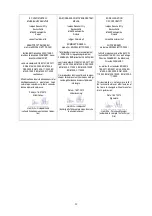
28
Position the guide, turn the machine on and carefully guide the part being worked against the saw
blade. Saw the part in a single operation.
Lengthwise cuts
Adjust the guide (15, FIG. 2) to the desired width relative to the saw blade.
Place the part to be worked against the saw guide. Keep in mind that the wider side of the part must
rest on the saw table. Guide wide parts manually along the saw blade.
NOTE: Always maintain a sufficient safe distance from the saw blade. When sawing narrow parts
(less than 120 mm), use a pusher (32, FIG. 3) for safety purposes.
1.
Unplug the machine from its power source.
2.
Wear work gloves.
3.
Remove the protective cover (28, FIG. 7) which is attached under the saw table.
4.
Position the guide to about 15°.
5.
Check that the saw head (19, FIG. 1) is in the “up” position.
6.
Using the pin wrench hold the blade’s exterior cover and loosen the hex head screw of the
saw shaft using the hex wrench.
7.
Lower the saw head to the “down” position and block the saw head’s blocking lever (20,
FIG. 9).
8.
Pivot the saw blade in its lower position using the removable handle.
9.
Completely unscrew the hex head screw.
10.
Replace the blade protector (26, FIG. 1) and carefully remove the saw blade from the bot-
tom. Before mounting the new blade, clean the saw blade housing with a rag or brush.
Attention: Follow the procedure in reverse to install the saw blade. The saw blade teeth must point
downwards and the direction of the arrow on the blade must correspond to that on the blade’s pro-
tective cover.
MAINTENANCE
-
Before beginning any work on the machine, unplug the machine from its power source.
-
For cleaning plastic components, use a damp rag. Do not use cleaning products, solvents or
pointed objects.
-
Remove all dirt from the saw table using an appropriate cleaning spray.
-
If motor braking time is not within a time lapse of 10 seconds, wear parts for the motor
brake must be replaced only by the manufacturer.
-
Regularly remove dust accumulated on the ventilation openings and moving parts mobiles
using a soft brush or a paintbrush.
-
Regularly lubricate moving metal parts.
Waste Electrical and Electronic Equipment (WEEE) warning
Meaning of crossed out wheeled dustbin:
Do not dispose of electrical appliances as unsorted municipal waste, use separate collection
facilities. Contact your local government for information regarding the collection systems
available. If electrical appliances are disposed of in landfills or dumps, hazardous substances
can leak into the groundwater and get into the food chain, damaging your health and well-
being. When replacing old appliances with new ones, the retailer is legally obligated to take
back your old appliance for disposals at least free of charge.


































